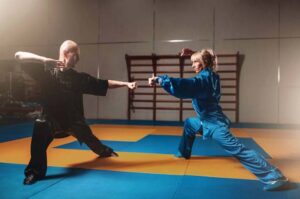Edited by DeShawn
Fist fights, getaway driving, a sniper showdown. These are three distinct, yet intrinsically related scenarios. These are all action scenes. Despite being some of the most exciting pieces of any story, action sequences are tricky to master. Writers often have fragments of compelling conflict in their pages but are unable to connect and refine them. The result is often choppy, disjointed clutter. In this article, we discuss how structure can impact two different kinds of action. In a second installment, we will review how flowing choreography can elevate a scene.
However, before we begin, what is an “action scene”? For the purpose of this article, an action scene is one in which story conflict physically manifests between characters. Scenes of verbal sparring, while compelling, must therefore be excluded for now.
Structuring Action Sequences
Structure. It’s the least sexy of all a writer’s tools but it is, perhaps, the most important one. This is doubly true for action scenes. A common problem writers encounter is describing a scene exactly as they intend the characters to experience it rather than the reader. The audience is told how characters react, but improper structure prohibits the audience from sharing the feeling. Let’s examine how we can remove these barriers between our reader and the story.
Shock
How does structure influence shock? Shock is meant to be sudden and off-putting. The best way to drive engagement is not from describing shocking events to a reader but by having them experience the shock through structure. If an action catches a character off guard, then it should catch the reader off guard as well.
For example:
The two patriarchs stood face to face, finally putting aside decades of conflict. Father Bartoz turned to the crowd with arms spread wide. “Let this be the cornerstone to a prosperous new—” His message was lost as a faint whooshing breezed by an instant before the arrow struck him square in neck.
The structure of the last sentence robs the audience of any surprise. The event is telegraphed long before it arrives. If the pretense is dropped, the reader could experience a much more sudden assassination.

The two patriarchs stood face to face, finally putting aside decades of conflict. Father Bartoz turned to the crowd with arms spread wide. “Let this be the cornerstone to a prosperous new—” Blood spurted from his neck as the wooden shaft of an arrow erupted from his Adam’s apple.
In this iteration, the reader is left just as shocked as the assembled characters, placing them firmly within the scene.
Panic
How could structure reinforce panic or losing control? These things are rarely present at the beginning of any physical conflict. If they were, any half-intelligent protagonist would avoid a contest they couldn’t handle. But perhaps a character is realizing they are out of their depth as the conflict wears on. A sense of panic should grow with these scenes. Consider the example of a getaway driver.
James hadn’t gone two blocks when blue lights began flashing in his rearview mirror. He gazed at the bags of cash in the back seat, then pressed down on the gas. Sirens wailed behind him as the car shot forward. James maneuvered his coupe around countless vehicles and sped through yellow lights. He wondered how long they’d chase him. He looked into his rearview. The lights were closer. James glanced about as he drove, hoping to find a way out before they closed in on him. Metal screeched as he forced himself through smaller and smaller gaps, leaving gouges of traded paint in his quarter-panels. The sirens blared around him. James barreled through endless traffic with blue lights encircling him. He shot through red lights and mounted curbs and bounded across medians. Suddenly, all that existed was whistling wind and the rumble of the engine and the money fluttering in the backseat as his wheels started skidding and the car began to roll.
First, notice the repetition of the police lights and sirens. These occur closer and closer together like the ticks of a quickening metronome. Their constriction of the prose mirrors the police’s constriction around James. This serves to reproduce James’ growing panic within the reader. Let’s now examine how the sections between these instances do the same.
- James hadn’t gone two blocks when blue lights began flashing in his rearview mirror. He gazed at the bags of cash in the back seat, then pressed down on the gas.
The structure of the above section performs two functions. Foremost, the segments are ordered to escalate the initial tension of the scene. The threat of James being pulled over establishes stress, but not much tension. When we reveal contraband in the backseat, the audience now understands conflict is imminent and they tense in anticipation. Finally, when James decides to flee, we are all left clutching the door of the passenger seat alongside him.
Now imagine if the first sentence had been, “James pressed down on the gas.” The audience would start at the most intense part and the later sentences would pull them down from that excitement. It would be like unwrapping a present when you know what’s inside. There’s no build, no anticipation.
The second function of this section is to establish James’ initial calm despite the tension. The ordering of these sentences is logical. They are neither abruptly short nor rambling. These sentences convey controlled thoughts and provide the writer with a wonderful base to erode as the situation devolves.
- Sirens wailed behind him as the car shot forward. James maneuvered his coupe around countless vehicles and sped through yellow lights. He wondered how long they’d chase him. He looked into his rearview.
In this portion, the sentences are still constructed normally. However, the audience now sees James devolve in his actions by driving recklessly. The situation is no longer under his complete command.

The lights were closer. James glanced about as he drove, hoping to find a way out before they closed in on him. Metal screeched as he forced himself through smaller and smaller gaps, leaving gouges of traded paint in his quarter-panels.
Sentence construction has begun to devolve. The previous, shorter sentences conveyed concise, controlled thoughts. These later sentences lengthen as James searches for an escape and drives erratically. This quickens reading by allowing fewer pauses. The audience is barreling along with James.
- The sirens blared around him. James barreled through endless traffic with blue lights encircling him. He shot through red lights and mounted curbs and bounded across medians. Suddenly, all that existed was whistling wind and the rumble of the engine and the money fluttering in the backseat as his wheels started skidding and the car began to roll.
In the final segment, conventions slip away. Just as someone reading aloud needs breaks to breathe, so, too, does an audience reading silently. The second-to-last sentence trades in a comma-separated list for conjunction-heavy rambling. Commas afford readers a mental breath, a pause (see what I did there?). When a writer deprives their audience of this, it simulates the breathlessness of the situation at hand. The last sentence employs this same conjunctions-over-commas strategy, but takes it up a notch by adding “…as his wheels started skidding”. This final portion would normally be better off as a new sentence. Not in this case. Here, we smash it into the preceding clauses to hurtle the reader forward, depriving them the reprieve a period would provide.
Next week’s article will discuss methods to write cohesive conflict with flow. However, before we get there, it’s worth noting that the suggestions here are specific to the listed intents (shock, panic). Consider dread and suspense. These are the opposite of shock. The best way to achieve these is to have the audience know of an impending action before the characters. Essentially, do the reverse of the suggestions for shock. Yet, this only reinforces the critical point: the structure of your writing must reinforce the emotion(s) you want to elicit.
For further insights on shock/suspense/tension, listen to Alfred Hitchcock’s opinions here:
- Suspense vs Mystery: https://www.youtube.com/watch?v=-Xs111uH9ss
- Shock vs Tension: https://www.youtube.com/watch?v=DPFsuc_M_3E




Great read! Looking forward to your next post!
The section on shock is one of those points that I could always identify when I read it, but could never figure out how to create it myself. Thank you!
I’m glad this was able to lend some clarity, Nathan!
I learned a lot from this article!